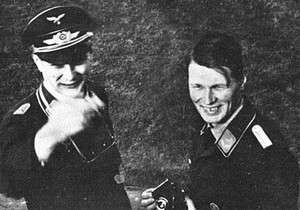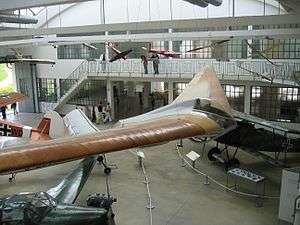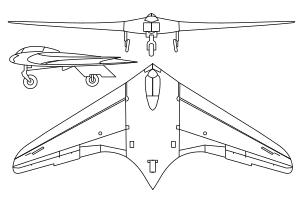Horten brothers
Walter Horten (born 13 November 1913 in Bonn; died 9 December 1998 in Baden-Baden, Germany) and Reimar Horten (born 12 March 1915 in Bonn; died 14 March 1994 in Villa General Belgrano, Argentina), sometimes credited as the Horten Brothers, were German aircraft pilots and enthusiasts. Although they had little, if any, formal training in aeronautics or related fields, the Hortens designed some of the most revolutionary aircraft of the 1940s, including the world's first jet-powered flying wing, the Horten Ho 229.

Biography
Early lives
Between the World Wars, the Treaty of Versailles limited the construction of German military airplanes. In response, German military flying became semi-clandestine, taking the form of civil "clubs" where students trained on gliders under the supervision of decommissioned World War I veterans. As teenagers, the Horten brothers became involved in such flying clubs.
This back-to-the-basics education, and an admiration of German avant-aircraft designer Alexander Lippisch, led the Hortens away from the dominant design trends of the 1920s and 1930s, and toward experimenting with alternative airframes — building models and then filling their parents' house with full-sized wooden sailplanes. The first Horten glider flew in 1933, by which time both brothers were members of the Hitler Youth.[1]

The Hortens' glider designs were extremely simple and aerodynamic, generally consisting of a huge, tailless albatross-wing with a tiny cocoon of a fuselage, in which the pilot lay prone. The great advantage of the Horten designs was the extremely low parasitic drag of their airframes.
During World War II
By 1939, with Adolf Hitler in power and the Treaty of Versailles no longer in effect, Walter and Reimar had entered the Luftwaffe as pilots. (A third brother, Wolfram, was killed flying a bomber over Dunkirk.) They were also called upon as design consultants, though Germany's aeronautical community tended to regard the Hortens not as part of the cultural elite. However, both were members of the NSDAP.[2]
Walter participated in the Battle of Britain, secretly flying as the wingman for Adolf Galland, and shot down seven British aircraft.[3]
In 1937, the Hortens began using motorized airplanes, with the debut of the twin-engined pusher-prop airplane H.VII (an earlier glider had a mule engine). The Luftwaffe, however, did not actually use many of the Hortens' designs until 1942, but gave enthusiastic support to a twin-turbojet-powered fighter/bomber design, designated under wartime protocols as the Horten H.IX.[4] For their completion of the three Ho 229 prototypes (V1,V2,V3) the Horten brothers were awarded 500,000 Reichmarks.[3]

Securing the allocation of turbojets was difficult in wartime Germany, as other projects carried higher priority due to their rank in the overall war effort. Although the turbojet-equipped Ho 229 V2 nearly reached a then-astonishing 800 km/h (500 mph) in trials, the production of the third prototype V3 was given over to the coachbuilder Gothaer Waggonfabrik, subsequently called Gotha Go 229. The Go 229 was captured by the U.S. Army at the end of World War 2, in which the completed but unflown V3 third prototype aircraft is presently housed at the Smithsonian Institution in Washington D.C.[2]
The Ho 229 had potential, but was too late to see service. The Horten brothers also worked on the Horten H.XVIII, an intercontinental bomber that was part of the Amerikabomber project. Among other advanced Horten designs of the 1940s was the supersonic delta-wing H.X, designed as a hybrid turbojet/rocket fighter with a top speed of Mach 1.4, but tested only in glider form (as the Horten H.XIII).
Post World War II
As the war ended, Reimar Horten emigrated to Argentina after failed negotiations with the United Kingdom and China,[5] where he continued designing and building gliders, one experimental supersonic delta-wing aircraft and the four-engined flying wing DINFIA IA 38 Naranjero, intended to carry oranges for export. Walter remained in Germany after the war and became an officer in the post-war German Air Force. Reimar died on his ranch in Argentina in 1994, while Walter died in Germany in 1998.
In the late 1940s, the personnel of Project Sign, the U.S. Air Force's flying saucer investigation, seriously considered the possibility that UFOs might have been secret aircraft manufactured by the U.S.S.R. based on the Hortens' designs.[6]
Aircraft
- Horten H.I
- Horten H.II Habichte
- Horten H.III
- Horten H.IV
- Horten H.V
- Horten H.VI
- Horten H.VII
- Horten H.XVIII
- Horten Ho 229
See also
- Amerikabomber
- Northrop YB-35
- Northrop YB-49
- Fábrica Militar de Aviones
- I.Ae. 34 Clen Antú
- I.Ae. 37
- I.Ae. 38 Naranjero
- I.Ae. 41 Urubú
- Nike PUL 9
- Alsomitra
- German inventors and discoverers
References
- "Hitler's Stealth Fighter", Michael Jorgensen. National Geographic. Retrieved February 25, 2016.
- "Two brothers, one wing", Philippe Ballarini. Aerostories. Retrieved March 16, 2010.
- "Under the radar inventions" Archived 2009-06-22 at the Wayback Machine, National Geographic. Retrieved March 16, 2010.
- "German flying wings during World War Two", E.T. Woolridge. Century of flight. Retrieved March 16, 2010.
- "Revisiting the National Socialist legacy", Oliver Rathkolb. Aldine Transaction, 2004. ISBN 0-7658-0596-0, ISBN 978-0-7658-0596-6. Retrieved March 16, 2010.
- Swords, Michael D. (2000). "UFOs, the Military, and the Early Cold War". In Jacobs, David M. (ed.). UFOs and Abductions: Challenging the Borders of Knowledge. Lawrence: University Press of Kansas. pp. 82–122. ISBN 0-7006-1032-4.
Bibliography
- Russell E. Lee, Only the Wing: Reimar Horten's Epic Quest to Stabilize and Control the All-Wing Aircraft (Washington, Smithsonian Institution Scholarly Press, 2012).